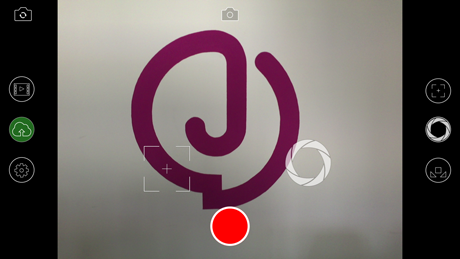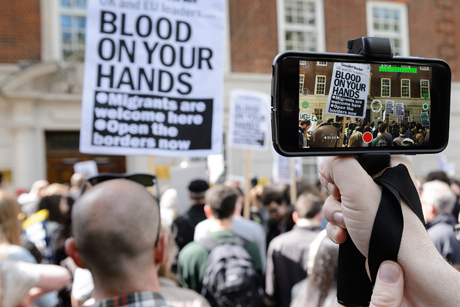
Smartphones and social media have turned the world of photojournalism and foreign correspondence on its head – time and time again images emerge from a story long before any trained reporters can get to the scene.
And this situation has been delivering the kind of shocking footage newsrooms dream of, footage which would otherwise be unattainable. Images from the Charlie Hebdo shootings, the murder of Lee Rigby, the Russian meteor strike, and countless images from Syria and Ukraine spring to mind – but it has also thrown the whole newsgathering process into a spin.
How can news organisations verify the images they are receiving? How should they credit the contributor? What about payment and responsibility? Could asking for eyewitness media encourage the public to enter dangerous situations?
Organisations like the EyeWitness Media Hub and Reveal have been investigating the field from an academic standpoint, researching case studies and debating best practice, but a new platform aims to take practical steps towards a new system.
"Verifeye Media is automating the curation, verification, distribution, licensing and monetisation of eyewitness media," John D McHugh, founder of the company told Journalism.co.uk, "and we're doing it in real time."
That is the intention, at least. As an experienced, award-winning photographer who spent a good chunk of the last 10 years embedded with troops in Afghanistan, McHugh is fully aware of the dangers involved in sourcing and using newsworthy footage. But also of its value.
Recent research by EMHub puts the use of eyewitness media at an average of 30 items per day at each of the news organisations studied, "but eyewitness media on its own is a pain in the arse," says McHugh, "because you spend more time and money trying to verify it than anything else."
As such, he has been signing up select members of his own network to test out the Verifeye app. Building a body of users who submit images from around the world to a central editorial hub is the first step, from which they are licensed to news organisations on a 50 per cent share, promising to pay contributors within seven days.

Testing the Verifeye app in the Journalism.co.uk offices, with the 'auto-upload' feature highlighted on the left. Image: Journalism.co.uk
Only footage captured through the app can be uploaded and, once the app goes public, only registered users will be able to upload images, complete with tags and keywords to make them easily findable by news editors.
That may seem to deny the serendipity of eyewitness media, the people at the scene uploading footage to their social networks, but McHugh intends to keep an eye out around big stories in the early months and encourage people on Twitter or Instagram to download his app and get paid for their work.
Verification and trust, tenets at the core of journalism itself, are the currencies Verifeye wants to trade in beyond the cold, hard cash.
"If the content can be proved to be real, it has a value," he said, "and it doesn't matter if it was a professional journalist that shot it or somebody's mum that stuck their head out the window. It really doesn't matter."
Users will get vetted as thoroughly as the media itself, though.Sometimes when you're in the field you lose perspective. I've been through itJohn D McHugh, Verifeye Media
Not only do the images come with the usual date, time and location metadata encrypted into the file, but Verifeye include a compass bearing and altitude reading, "so we can tell where you were, when you were there, which direction you were facing and whether you're on ground floor or the tenth story of the building".
When the app's auto-upload feature is switched on, Verifeye editors can watch all the information appear on a map within seconds, reducing the time from submission to publication.
"All [publishers] have to do is sign in, go through and say 'I need something from the bomb attack in Kabul this morning' and they see 20 pieces. They can stick what they want in the basket, go to the end, pay for them and use them."
Without a subscription model users are free to search and browse media, a policy McHugh is aware may be open to abuse. But ultimately he thinks it will be more cost-effective for users to license the best images directly, rather than search elsewhere.
That was certainly the case at Mashable, which became the first Verifeye client last week as Irish citizens voted to legalise gay marriage.
"I just went on and looked what was available and the video of the girl proposing to her girlfriend just jumped out at me," said Louise Roug, Mashable's global news editor, "and it was really easy to grab and put in the story and we had tremendous success with it."
Screengrabs from the video have already been lifted by many other news organisations without licence or credit, despite still publishing a "Verifeye Media" watermark in the corner, but from an editor's perspective, Roug said the process checked all the boxes for ease of use while supporting the contributor.
"It was very obvious that it was designed by someone with the concerns of freelancers in mind," Roug, who herself has a background as a war reporter, told Journalism.co.uk, "and these are some of the things that we wrestle with all the time."
Freelancer's safety, swift payment, a check-in system and hostile environment training are all elements of support that can be lost as more and more freelancers are used, but at a greater disconnect from the news outlet itself.
"We have to use freelancers but we want to make sure the ethics are all there," she said.
Because not all footage will be as heart-warming as the first to be licensed.
As a veteran of some of the worst the industry has to offer, including taking a bullet for his profession in Afghanistan, McHugh feels a duty to his contributors that may not be as strong at other eyewitness media startups solely in it for the money.
Verifeye is the app and company he wished he had when he first went freelance, giving professionals another string to their bow that submits footage for publication in near real-time, and a quick avenue for eyewitnesses to get paid.We are making clients pay at point of purchase so we can pay freelancers quicklyJohn D McHugh, Verifeye Media
"But what I won't be doing is taking stuff from everyone and anyone at any old time," he said, "because that would be dangerous and we could get somebody killed."
As an example, he highlighted the work of a friend currently embedded with Peshmerga troops in Iraq.
"Let's say he sends through some content, I come to the newswire and I look at it and I go 'holy shit, he's in a gun fight with IS'. I go through it, put our graphic content cover on it and then I put it on the newswire.
"What I also do is say this is 'really full-on stuff, really dangerous' and I'll put an amber light on his account. And if some more stuff comes in tomorrow and it's really good, but it's really hairy I'll put another amber light on."
Three amber lights and Verifeye will give the user a "cooling-off period" when their footage won't be licensed.
"Sometimes when you're in the field you lose perspective. I've been through it. So I'll ring him up and say 'we're really worried about you, you've been there for ages, your stuff is great but it's really full-on'.
"And if we're getting someone who is getting amber lights on a regular basis then we will shut down their account and say 'listen, you're a nutter'. We don't want to get anyone killed."

The Verifeye app in action, set to video mode. Image: Verifeye Media
Many outlets have issued statements declaring that they won't take footage from freelancers in Syria but that promise only goes as far as the quality of the content, says McHugh. If it's good, it will run, but that also carries with it a degree of responsibility over the identity of the contributor, not just their actions.
Attaching a name or a social profile to footage from a dangerous area could have serious repercussions for the contributor, especially if they are a local eyewitness, so for now, all users will be anonymous to the news organisation.
Verifeye will take commissions from news outlets, however, if they know they have a contributor in a certain area but with all the appropriate support in place "because as soon as I ask someone to do something then we're responsible for them," said McHugh.
Beyond safety, his concern is for building a market. Verifeye is a "21st century visual news agency" aiming for the middle ground between the longstanding likes of Reuters or Getty, with their trained correspondents, and the new social newswires like Storyful or NewZulu, which actively seek out eyewitness media from around the web.
It will not be easy. The system and app are still both in beta, but McHugh hopes the growing network of contributors and clients is enough proof of concept to take the app public for both citizen journalists and professionals alike.
"Even if you have your big cameras on you and you want to shoot some amazing stuff for World Press Photo, fine, shoot some video first and get it up to me straight away so at least we can report the breaking news event and get it out there."
There may be many people "setting up UGC marketplaces because they see some money to be had but they don't know anything about journalism". McHugh has spent a lot of time thinking through how he can make life easier for both news outlets and freelancers, and believes he may have found the answer.
"Freelancers have been complaining for years about being paid late, saying that it puts their lives at risk when they have to make cuts to their security plan because they are short of money they are owed.
"We are making clients pay at point of purchase so we can pay freelancers quickly, and this could very genuinely save lives."
Roug agreed. "This allows me to buy a video where I know the shooter has training and has all the safety mechanisms in place and the ethical component of this is the key feature," she said.
"When it comes to freelancers this is above and beyond [other newswires] because it has that ethical component."
Free daily newsletter
If you like our news and feature articles, you can sign up to receive our free daily (Mon-Fri) email newsletter (mobile friendly).
Related articles
- Digital journalism expert Alastair Reid on TikTok, AI and burnout
- Three audio apps to turn your listeners' voices into podcasts and audio features
- App for journalists: MyScoop, for commissioning mobile and citizen journalism
- Weekly journalism news update: Citizen journalism, tackling misinformation and Google algorithms
- Live-streaming app Happs is set to innovate breaking news









